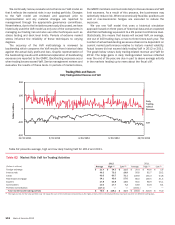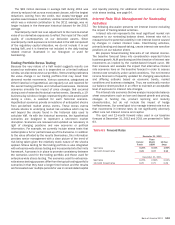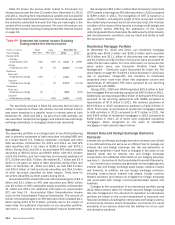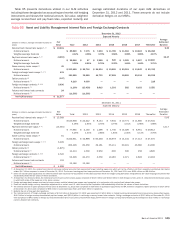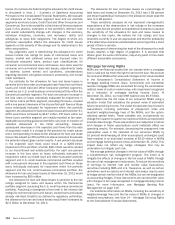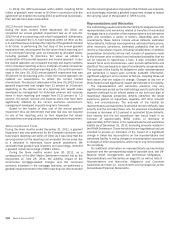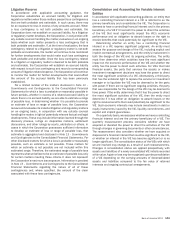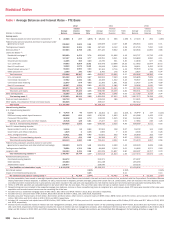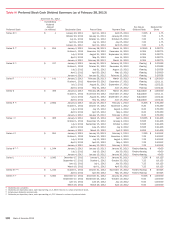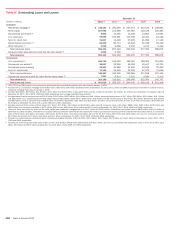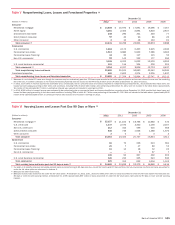Bank of America 2012 Annual Report Download - page 123
Download and view the complete annual report
Please find page 123 of the 2012 Bank of America annual report below. You can navigate through the pages in the report by either clicking on the pages listed below, or by using the keyword search tool below to find specific information within the annual report.Bank of America 2012 121
In applying the applicable accounting guidance, we monitor
relevant tax authorities and change our estimate of accrued
income taxes due to changes in income tax laws and their
interpretation by the courts and regulatory authorities. These
revisions of our estimate of accrued income taxes, which also may
result from our income tax planning and from the resolution of
income tax controversies, may be material to our operating results
for any given period.
Net deferred tax assets, reported as a component of other
assets on the Corporation’s Consolidated Balance Sheet,
represent the net decrease in taxes expected to be paid in the
future because of net operating loss (NOL) and tax credit
carryforwards and because of future reversals of temporary
differences in the bases of assets and liabilities as measured by
tax laws and their bases as reported in the financial statements.
NOL and tax credit carryforwards result in reductions to future tax
liabilities, and many of these attributes can expire if not utilized
within certain periods. We consider the need for valuation
allowances to reduce net deferred tax assets to the amounts we
estimate are more-likely-than-not to be realized.
While we have established some valuation allowances for
certain state and non-U.S. deferred tax assets, we have concluded
that our various estimates of future taxable income will be
sufficient to realize all U.S. federal and U.K. deferred tax assets,
including NOL and tax credit carryforwards, that are not subject to
any special limitations (such as change-in-control limitations) prior
to any expiration. The majority of our U.K. net deferred tax assets,
which consist primarily of NOLs, are realizable by subsidiaries that
have a recent history of cumulative losses. These deferred tax
assets related to NOLs will be realized over an extended number
of years. Significant decreases to our estimates of future taxable
income could materially change our conclusions about how much
of our tax attributes and other deferred tax assets are more-likely-
than-not to be realized prior to their expiration. See Note 20 –
Income Taxes to the Consolidated Financial Statements for a table
of significant tax attributes and additional information.
Goodwill and Intangible Assets
Background
The nature of and accounting for goodwill and intangible assets
are discussed in Note 1 – Summary of Significant Accounting
Principles and Note 9 – Goodwill and Intangible Assets to the
Consolidated Financial Statements. Goodwill is reviewed for
potential impairment at the reporting unit level on an annual basis,
which for the Corporation is performed as of June 30, and in interim
periods if events or circumstances indicate a potential impairment.
A reporting unit is an operating segment or one level below. As
reporting units are determined after an acquisition or evolve with
changes in business strategy, goodwill is assigned to reporting
units and it no longer retains its association with a particular
acquisition. All of the revenue streams and related activities of a
reporting unit, whether acquired or organic, are available to support
the value of the goodwill.
We use the reporting units’ allocated equity as a proxy for the
carrying amount of equity for each reporting unit in our goodwill
impairment tests as we do not maintain a record of equity as
defined under GAAP at the reporting unit level. Allocated equity
includes economic capital, goodwill and a percentage of intangible
assets allocated to the reporting units. The allocation of economic
capital to the reporting units utilized for goodwill impairment
testing has the same basis as the allocation of economic capital
to our operating segments. Economic capital allocation plans are
incorporated into the Corporation’s financial plan which is
approved by the Board on an annual basis. Allocated equity is
updated on a quarterly basis.
The Corporation’s common stock price remained low during
2012 and 2011. During these periods, our market capitalization
remained below our recorded book value. We estimate that the
fair value of all reporting units with assigned goodwill in aggregate
as of the June 30, 2012 annual goodwill impairment test was
$219.5 billion and the aggregate carrying value of all reporting
units with assigned goodwill, as measured by allocated equity was
$138.4 billion. The common stock market capitalization of the
Corporation at June 30, 2012 was $88.2 billion ($125.1 billion
at December 31, 2012). As none of our reporting units are publicly-
traded, individual reporting unit fair value determinations do not
directly correlate to the Corporation’s stock price. Although we
believe it is reasonable to conclude that market capitalization
could be an indicator of fair value over time, we do not believe that
our current market capitalization reflects the aggregate fair value
of our individual reporting units.
Estimating the fair value of reporting units is a subjective
process that involves the use of estimates and judgments,
particularly related to cash flows, the appropriate discount rates
and an applicable control premium. We determined the fair values
of the reporting units using a combination of valuation techniques
consistent with the market approach and the income approach
and also utilized independent valuation specialists.
The market approach we used estimates the fair value of the
individual reporting units by incorporating any combination of the
tangible capital, book capital and earnings multiples from
comparable publicly-traded companies in industries similar to that
of the reporting unit. The relative weight assigned to these
multiples varies among the reporting units based on qualitative
and quantitative characteristics, primarily the size and relative
profitability of the reporting unit as compared to the comparable
publicly-traded companies. Since the fair values determined under
the market approach are representative of a noncontrolling
interest, we added a control premium to arrive at the reporting
units’ estimated fair values on a controlling basis.
For purposes of the income approach, we calculated
discounted cash flows by taking the net present value of estimated
future cash flows and an appropriate terminal value. Our
discounted cash flow analysis employs a capital asset pricing
model in estimating the discount rate (i.e., cost of equity financing)
for each reporting unit. The inputs to this model include the risk-
free rate of return, beta, which is a measure of the level of non-
diversifiable risk associated with comparable companies for each
specific reporting unit, market equity risk premium and in certain
cases an unsystematic (company-specific) risk factor. The
unsystematic risk factor is the input that specifically addresses
uncertainty related to our projections of earnings and growth,
including the uncertainty related to loss expectations. We utilized
discount rates that we believe adequately reflect the risk and
uncertainty in the financial markets generally and specifically in
our internally developed forecasts. We estimated expected rates
of equity returns based on historical market returns and risk/return
rates for similar industries of each reporting unit. We use our
internal forecasts to estimate future cash flows and actual results
may differ from forecasted results.



